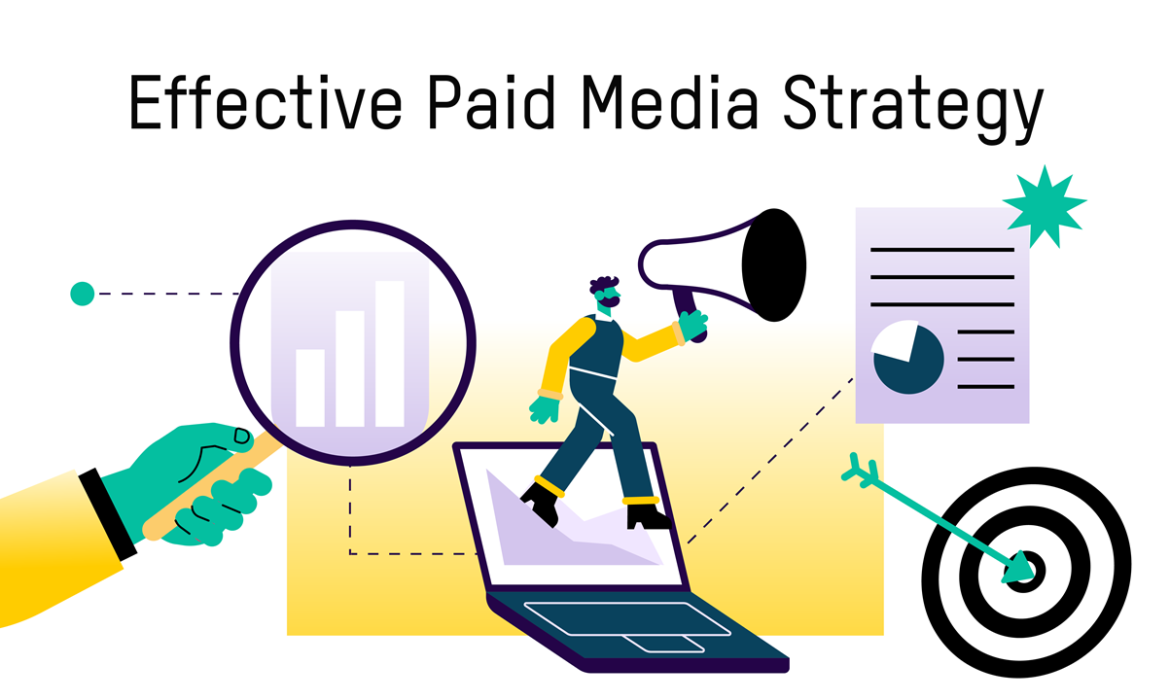Paid Strategy Integration in SEO: Enhancing Online Clarity
In the current digital world, companies looking to thrive in cutthroat industries must have a strong online presence. Paid media stands out among the many digital marketing techniques as an effective means of increasing visibility, attracting relevant traffic, and eventually increasing conversions. Paid media, when carefully combined with search engine optimization (SEO), can open up a whole new world of possibilities for companies trying to make the most impression online. Let’s examine the nuances of paid media and how to use it to increase your SEO-paid strategy without taking precedence over natural search engine optimization efforts.
The Mergence of SEO and Paid Media
Even while SEO and paid media might seem like different marketing platforms, they can work together to provide beneficial results. Despite popular belief, including paid media in your SEO plan doesn’t hurt organic efforts—rather, it enhances them by broadening your audience and drawing in quality prospects. This is how SEO and paid media work together to improve your online visibility.
Increased Exposure and Focused Traffic
Enhancing a website’s organic presence in search engine results pages (SERPs) is the main objective of SEO. But getting to the top of the rankings might take a while, particularly in fields with intense competition. By prominently displaying advertisements at the top of search results, paid media provides a shortcut and guarantees instant visibility to visitors who are actively looking for pertinent information. Paid media brings tailored traffic to your website by focusing on particular demographics and phrases, which raises the possibility of conversions and income production.
Targeting Strategic Keywords
Any SEO plan must start with keywords since they link user intent with pertinent content. Paid strategy campaigns use keyword targeting to make sure people looking for items or services comparable to yours see your advertising. You may drive targeted traffic to your website and gradually raise your organic search rankings for high-converting keywords by finding them and using them in your paid advertisements.
Comprehending Paid Media Dynamics
Paid media refers to a variety of online advertising formats, including sponsored content, display adverts, and pay-per-click (PPC) campaigns. Paid media is different from organic techniques like social media interaction or content marketing in that it requires spending money to get ad positions across digital platforms. Businesses may guarantee instant visibility to their target audience by purchasing ad space, which will increase website traffic and brand exposure.
Data-Based Perspectives
The capacity of sponsored advertising to offer useful data through analytics and tracking technologies is one of its biggest benefits. Through the monitoring of indicators like click-through rates, conversion rates, and demographic information, organizations can acquire important insights into the behaviour and preferences of their target audience. These insights support data-driven decision-making for organic SEO tactics like content production and keyword targeting, in addition to providing information for paid strategy campaign optimization.
Quickened Exposure of Brand
Increasing brand recognition is crucial to winning over customers’ credibility and confidence. Paid strategy quickens the process of increasing brand visibility by exposing your business to a larger audience in less time than organic techniques like content marketing and social media.
Enhancing the User Interface
User experience (UX) is a key factor in evaluating a website’s success in today’s digital environment. Every element of the user journey, including mobile responsiveness and page load speed, affects engagement and conversion rates. Through paid marketing, companies may optimize user experience and boost conversion rates by directing consumers to specific landing pages based on their search queries or preferences. You may facilitate a smooth transition for visitors from their first click to their ultimate purchase by placing sponsored advertising in line with relevant, high-quality content.
To sum up, paid advertising is an invaluable tool for digital marketers, providing unmatched chances to boost online presence and attract specific traffic. Paid media may boost the success of your organic efforts when used strategically in conjunction with SEO, hastening your journey to online success. In today’s competitive digital market, businesses may maximize their exposure, generate qualified leads, and eventually achieve sustainable growth by utilizing the synergy between paid media and SEO. Accept the possibility that bought media may improve your SEO paid strategy and help your brand become more well-known and profitable.
The Complete Handbook of Niche Link Building for SEO Achievement
SEO (Search Engine Optimization) continues to be a vital component in the dynamic world of digital marketing since it generates natural traffic for websites. Of all the SEO tactics available, link building is one of the most important for improving search engine rankings and creating authority within your industry. But in the world of its markets, link-building needs a customised strategy to guarantee efficacy and relevance. We explore the nuances of speciality link development in this extensive book, providing tips and tactics to improve your SEO efforts.
Knowing How to Build Niche Links
Building relationships inside your speciality group is the main goal of its building, as opposed to generic link building, which aims to reach a wider audience. Acquiring links from reputable sites in your industry raises your website’s search engine ranking and establishes your authority and relevance to your intended audience.
Its Significance
In search engine optimization, relevancy is critical. Links originating from websites that share your content or themes are highly valued by search engines. Give priority to websites that are directly linked to it when obtaining backlinks. If your website is about organic gardening, for example, getting connections from seed companies, gardening blogs, or agricultural colleges would be better than getting links from irrelevant sites.
Superior Quality Compared to Quantity
When it comes to creating links, quality always wins out over quantity. Your SEO efforts may benefit more from a small number of high-quality backlinks from reputable websites in your niche than from a large number of low-quality connections. Concentrate on obtaining backlinks from reliable sites that have a solid track record of creating high-quality content and high domain authority. Investigate it carefully to find possible link opportunities, then rank the websites that best fit your audience’s interests and brand values.
Developing Connections with Specialist Influencers
Developing deep connections with thought leaders and influencers in its markets can greatly improve your link-building efforts. Through industry events, joint ventures, and social media, interact with influencers in your sector. You may boost the possibility that influencers would link back to your website or mention your company in their content by building a relationship with them and offering them value. Keep in mind that reaching out to influencers should be done with sincerity and authenticity, with an emphasis on developing real relationships rather than just obtaining backlinks
Making Eye-Catching Specialty Content
A key component of successful link-building is content. To gain backlinks from reputable websites in your field, you need to provide interesting, high-quality content that appeals to your target market. Do in-depth keyword research to find trends and subjects that are pertinent to your area. Provide educational guides, films, infographics, and articles that speak to the needs and interests of your readers. You become a respected authority in your niche and draw in natural backlinks by continuously creating high-quality content.
Keeping an Eye on and Examining Your Link Profile
Monitoring and analyzing your link profile regularly is necessary for effective link building. Audit your backlink profile regularly to find any spammy or low-quality links that could undermine your SEO efforts. want tools like Ahrefs, Moz, or Google Search Console to track backlinks, keep an eye on changes to your link profile, and spot areas that could need work. Your link development activities should support your overall SEO strategy, so make sure you’re alert and aggressive in managing your link profile.
In conclusion, by prioritizing relevance, quality, and relationship-building within your niche, you can establish authority, improve search engine rankings, and attract targeted traffic to your website
Unleashing the Power of Data and Analytics
Organizations from all sectors depend increasingly on analytics and data-driven insights in today’s quickly changing digital ecosystem to obtain a competitive edge, improve operational effectiveness, and inform strategic decision-making. With the help of analytics and data, businesses can now foresee trends, find hidden patterns, and take actionable insights from massive amounts of data, making them valuable assets. Its effect is ubiquitous in modern corporate operations, ranging from speeding internal procedures to optimizing marketing efforts and enhancing customer experiences.
The Development of Data and Analytics:
As a result of technological breakthroughs and the rapid expansion of data, the analytics sector has experienced tremendous change throughout time. More advanced approaches like machine learning, artificial intelligence (AI), and predictive analytics have replaced conventional ways of data analysis. With the use of these breakthroughs, firms can now more accurately predict market trends, spot possible hazards, and seize new opportunities by deriving deeper insights from complicated datasets.
The Use of Data in Making Decisions:
Well-informed decision-making is essential to an organization’s success in today’s data-driven world. Businesses can stop depending just on gut feelings or conjectures and start making data-driven decisions supported by actual evidence by utilizing analytics. Organizations may reduce risks, maximize performance, and maintain a competitive edge in a market that is becoming more and more competitive by utilizing data-driven insights in decision-making processes related to product pricing, resource allocation, and strategic initiative development.
Driving Business Transformation:
Data and analytics have the power to not only enable small-scale enhancements but also to fundamentally alter businesses. Organizations can find new revenue streams, optimize procedures, and spot inefficiencies by examining historical data and real-time indicators. Additionally, businesses may customize client experiences, target particular market segments with products and services, and cultivate enduring customer loyalty thanks to data-driven insights.
Increasing Operational Efficiency:
Analytics is essential for streamlining internal procedures, raising output, and cutting expenses in businesses. Data and analytics help companies find bottlenecks, optimize workflows, and make data-driven decisions that lead to operational excellence in a variety of fields, including supply chain management, labour optimization, and predictive maintenance. By applying analytics, firms can improve workflow automation and resource allocation, leading to increased efficiency and agility in a dynamic business environment.
Handling the Difficulties of Privacy and Data Governance:
Although there is no denying the advantages of analytics and data, businesses also need to manage the complicated world of privacy, security, and data governance laws. With the rise in data breaches and privacy issues, it is critical to protect sensitive data and make sure regulations are followed. Building consumer trust and protecting the integrity of data assets requires putting in place strong data governance structures, enforcing strict security measures, and abiding by data privacy laws.
The Future of Analytics:
With continuous technical advancements and the increasing amount of data produced by networked devices and digital platforms, its future appears to be extremely promising. Predictive analytics and prescriptive insights will become more possible as AI and machine learning algorithms advance. This will allow businesses to foresee market trends, reduce risks, and seize new opportunities with previously unheard-of speed and precision.
To sum up, data and analytics have become critical resources for businesses looking to prosper in a data-driven and fiercely competitive corporate environment. Through the utilization of analytics, companies may convert unstructured data into meaningful insights that facilitate well-informed decision-making, optimise operational effectiveness, and promote creativity in all facets of their business operations. Businesses that adopt its strategies will be best positioned to thrive in the digital era as long as technology and data volumes continue to increase.
Content Marketing Power to Drive Growth in the Digital Age
Businesses are constantly looking for creative ways to stand out from the competition and draw in their target audience in today’s fast-paced digital market. In an ever-changing landscape, it has become a potent instrument that helps businesses engage with their customers, increase brand recognition, and foster long-term expansion. This post delves further into the topic of it, examining its importance, tactics, and effects on contemporary companies.
Comprehending Content Marketing
Creating and disseminating worthwhile, pertinent, and captivating information is the foundation of it, which aims to draw in and hold onto a target audience. In contrast to conventional advertising, which promotes goods or services directly.
The Importance of Content Promotion
It is a welcome diversion at a time when customers are constantly exposed to commercials and sales pitches. Brands can break through the clutter and connect with their audience more deeply by producing top-notch content that informs, entertains, or inspires. Additionally, it enables companies to stand out in crowded markets, demonstrate their subject-matter expertise, and build thought leadership.
Essential Elements of an Effective Content Marketing Plan
Research on Audiences: Crafting content that resonates with your target audience requires an understanding of their requirements, preferences, and pain areas. To understand the demographics, interests, and online habits of your audience, conduct in-depth research.
Content Planning: Create a thorough content strategy in line with the insights of your target audience and your business goals. Ascertain which content formats—blog articles, videos, infographics, or podcasts—will best captivate your audience.
High-quality content creation: Involves concentrating on producing well-written, pertinent, and educational information. For the purpose of captivating readers and building credibility, always put quality before quantity when creating blog posts, videos, or images.
Content Distribution: Once you’ve produced engaging content, expand your audience by using a variety of distribution methods. To get the most visibility and interaction, distribute information via email newsletters, social media, your website, and trade journals.
Engagement & Interaction: Promote audience participation by asking for and receiving questions, comments, and feedback about your work. Interact with your audience by answering questions, leaving comments, and promoting insightful dialogue about your company and products.
Measurement and Optimization: Monitor important performance indicators to gauge the success of your its campaigns, such as website traffic, engagement rates, and conversion rates. Refine your approach, maximize the effectiveness of your material, and promote ongoing development with data-driven insights.
Content Marketing’s Effect on Business Growth
When done well, It may provide companies with a wide range of advantages, such as:
Enhanced Brand Awareness:
Brands can become more visible and make a lasting impression on consumers by regularly producing high-quality content.
Enhanced Customer Engagement: Content that engages users builds stronger bonds with them and motivates social media sharing, brand advocacy, and return visits.
Increased Discoverability and Organic Traffic to Your Website:
Well-written content that is optimized for pertinent keywords can raise your website’s search engine ranks and improve its discoverability.
Lead Generation and Conversion:
Good content draws in prospects and directs them through the sales funnel to become customers. It is a potent instrument for lead generation.
Building Credibility and Trust:
Brands can gain the audience’s trust and loyalty by presenting themselves as knowledgeable and authoritative sources within their sector through the creation of useful and authoritative content.
In the current digital era, It is now essential for companies looking to prosper in a cutthroat market. Brands may foster meaningful connections, establish a stronger connection with consumers, and eventually achieve sustainable growth by producing content that is valuable, relevant, and engaging. Adopting a strategic approach to content marketing will remain crucial for staying ahead of the curve and achieving long-term success as technology advances and consumer preferences change.




